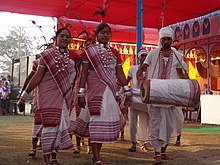
Back Курух Byelorussian ওরাওঁ Bengali/Bangla Oraons Catalan Oraonit Finnish उराँव Hindi Օրաոններ Armenian Ораондар Kazakh ഒറാവോൺ Malayalam Ораоны Russian ᱫᱷᱟᱸᱜᱚᱲ SAT
Kurukh | |
|---|---|
 Kurukh in traditional clothes performing dance | |
| Total population | |
| 3.8 million (2011) | |
| Regions with significant populations | |
| 3,696,899[1] | |
| Jharkhand | 1,716,618 |
| Chhattisgarh | 748,739 |
| West Bengal | 643,510 |
| Odisha | 358,112 |
| Bihar | 144,472 |
| Assam | 39,739 (1921)[2] |
| Tripura | 12,011[3] |
| 85,846[4] | |
| 37,424[5] | |
| 4,200[6] | |
| Languages | |
| Kurukh • Sadri • Odia • Hindi • Bengali | |
| Religion | |
| Hinduism, Christianity, Sarnaism[7] | |
| Related ethnic groups | |
The Kurukh or Oraon, also spelt Uraon or Dhangad,[8] (Kurukh: Karḵẖ and Oṛāōn) are a Dravidian speaking ethnolinguistic group inhabiting Chhotanagpur Plateau and adjoining areas - mainly the Indian states of Jharkhand, Odisha, Chhattisgarh, and West Bengal.[9] They predominantly speak Kurukh as their native language, which belongs to the Dravidian language family.[10] In Maharashtra, Oraon people are also known as Dhangad.[11][12]
Traditionally, Oraons depended on the forest and farms for their ritual practices and livelihoods, but in recent times, they have become mainly settled agriculturalists. Many Oraon migrated to tea gardens of Assam, West Bengal and Bangladesh as well as to countries like Fiji, Guyana, Trinidad and Tobago and Mauritius during British rule, where they were known as Hill Coolies.[8][13] They are listed as a Scheduled Tribe in seven Indian states for the purpose of reservation system.[14]
- ^ "A-11 Individual Scheduled Tribe Primary Census Abstract Data and its Appendix". censusindia.gov.in. Office of the Registrar General & Census Commissioner, India. Retrieved 3 November 2017.
- ^ "Estimated Population by Castes, 5. Assam – Census 1951" (PDF). Office of the Registrar General, India. 1954. p. 9.
- ^ "Statement 1: Abstract of speakers' strength of languages and mother tongues - 2011". www.censusindia.gov.in. Office of the Registrar General & Census Commissioner, India. Retrieved 7 July 2018.
- ^ "Table 1.4 Ethnic Population by Group and Sex" (PDF) (in Bengali). Bangladesh Bureau of Statistics. 2021. p. 33.
- ^ "National Population and Housing Census 2011: Social Characteristics Tables" (PDF). Nepal Census – via Government of Nepal.
- ^ "Oraon of Bhutan". PeopleGroups. Retrieved 28 January 2020.
- ^ Cite error: The named reference
Winston2006was invoked but never defined (see the help page). - ^ a b "The Long Journey: From India to Guyana". Guyana Chronicle. 5 May 2014.
- ^ Hasnain, Nadeem (2021). Tribal India (7th ed.). Delhi: Palaka Prakashan. p. 136.
- ^ Prasad, R. R. (1996). Encyclopaedic Profile of Indian Tribes, Volume 1. Discovery Publishing House. ISBN 9788171412983.
- ^ Singh, Kumar Suresh; Mehta, B. V.; Anthropological Survey of India (2004). Maharashtra Part 3. Anthropological Survey of India. p. 1585. ISBN 9788179911020.
- ^ Ministry of Tribal Affairs, Government of India (December 2002). 27th report of Standing Committee on Labour and Welfare with regards to SCs and STs order (Second Amendment) Bill, 2002 (PDF) (Report). Archived from the original (PDF) on 24 October 2020.
- ^ "Oraons - Dictionary definition of Oraons". Encyclopedia.com. Retrieved 14 October 2017.
- ^ "List of notified Scheduled Tribes" (PDF). Census India. Archived from the original (PDF) on 7 November 2013. Retrieved 9 February 2019.